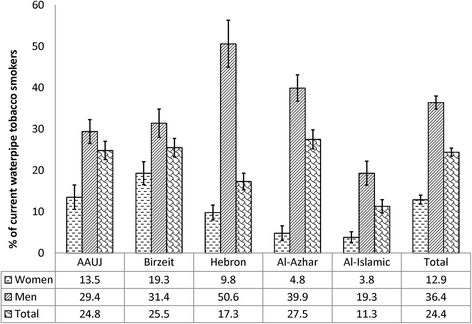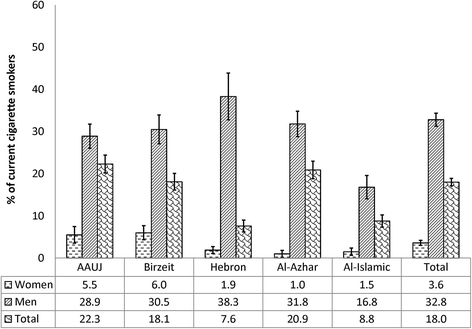Waterpipe and cigarette tobacco smoking among Palestinian university students: a cross-sectional study
- PMID: 28693529
- PMCID: PMC5504745
- DOI: 10.1186/s12889-017-4524-0
Waterpipe and cigarette tobacco smoking among Palestinian university students: a cross-sectional study
Erratum in
-
Erratum to: BMC Public Health, Vol. 18.BMC Public Health. 2017 Sep 22;17(1):736. doi: 10.1186/s12889-017-4709-6. BMC Public Health. 2017. PMID: 28938882 Free PMC article. No abstract available.
Abstract
Background: During the last two decades, waterpipe tobacco smoking (WTS), also known as hookah, witnessed a global increase in use, especially among youth. Little information is known about the burden of WTS among Palestinian youth. A cross-sectional study was conducted to estimate the prevalence of WTS and cigarette smoking and explore the associated factors among a sample of Palestinian university students.
Methods: 1891 students, from five Palestinian universities in the West Bank and Gaza Strip, completed a self-administered, web-based survey in 2014-2015. The questionnaire, which was based on the Global Adults Tobacco Survey (GATS), had questions on WTS and cigarette smoking patterns and socio-demographic and university-related characteristics. Binary logistic regression analyses were computed to investigate associated factors with WTS and cigarette smoking.
Results: 50.9% of the sample was women. The mean age was 20.1 ± 2.0. Overall, 30.0% of participants were current tobacco smokers and 33.4% reported ever smoking tobacco through a waterpipe. The prevalence of current WTS (24.4%) surpassed the prevalence of current cigarette smoking (18.0%), with a significantly higher prevalence among men compared to women. The gender gap for WTS (36.4% vs. 12.9%) was smaller than that for cigarette smoking (32.8% vs. 3.6%). Binary logistic regression models for the total sample (men and women) revealed that men were more likely to be current waterpipe and cigarette tobacco smokers compared to women (AOR = 4.20, 95% CI = 3.22-5.48, and AOR = 10.91, 95% CI = 7.25-16.42, respectively). Geographic area of residence, faculty of study and self-reported academic achievement were also associated with the likelihood of being current waterpipe and cigarette tobacco smokers.
Conclusion: A high prevalence of WTS was reported among our study sample, and it surpassed the prevalence of cigarette smoking. Interventions to curb the practice of tobacco smoking among Palestinian youth should be tailored differently to WTS and cigarette smoking, be gender-sensitive and specific and target the regional variation in the smoking behavior.
Keywords: Cigarette smoking; Gender; Occupied Palestinian territory; Public health; University students; Waterpipe tobacco smoking; Youth.
Conflict of interest statement
Ethics approval and consent to participate
Ethics approval statement:
Consent to participate: An electronic consent to participate question was included in the questionnaire.
Consent for publication
Not applicable.
Competing interests
The authors declare that they have no competing interests.
Publisher’s Note
Springer Nature remains neutral with regard to jurisdictional claims in published maps and institutional affiliations.
Figures



References
-
- World Health Organization . WHO Report on the Global Tobacco Epidemic, 2008. Geneva: The MPOWER package; 2008.
-
- World Health Organization, WHO report on the global tobacco epidemic, 2011: warning about the dangers of tobacco. Geneva; 2011.
-
- World Health Organization, Global action plan for the prevention and control of noncommunicable diseases 2013–2020. Geneva; 2013.
-
- World Health Organization, WHO global report on trends in prevalence of tobacco smoking 2015. 2015.
-
- WHO Study Group on Tobacco Product Regulation (TobReg), Waterpipe tobacco smoking: health effects, research needs and recommended actions for regulators - 2nd ed. World Health Organization; 2015.
MeSH terms
LinkOut - more resources
Full Text Sources
Other Literature Sources
Medical
Miscellaneous

